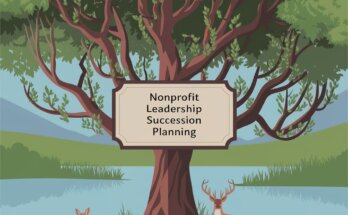When it comes to running a successful nonprofit, having an effective leader at the helm can make all the difference. But what exactly does it mean to be an effective nonprofit leader?
It’s not just about having a vision or a passion for the cause; it’s about embodying certain traits that allow you to inspire your team, engage with donors, and drive your organization toward achieving its mission.
In this post, we’ll explore some of the key traits that set exceptional nonprofit leaders apart and provide practical examples that any organization can apply.
Stick around, and you might just discover what it takes to elevate your leadership game.
1. Visionary Thinking
A great nonprofit leader needs to be a visionary. They see beyond the immediate challenges and have a clear picture of the future they want to create.
This long-term vision allows them to set goals that are ambitious yet achievable and to chart a path toward those goals.
Visionary thinking also helps leaders adapt to changes in the nonprofit landscape, such as new funding opportunities or shifts in donor expectations.
Example: Think of a nonprofit leader who starts an organization to combat youth homelessness. Rather than just focusing on immediate relief like shelters, they envision a future where every young person has access to affordable housing and education opportunities. This vision inspires their team to develop programs that address the root causes of homelessness and not just the symptoms.
2. Empathy and Active Listening
Empathy is one of the most important traits of an effective nonprofit leader. Understanding the needs and experiences of the people you serve—and your team—is crucial for building trust and strong relationships.
Leaders who listen actively to their staff, volunteers, and beneficiaries can better align their programs with the community’s needs. They create a culture where everyone feels heard and valued.
Example: Imagine a nonprofit focused on providing mental health services. An empathetic leader takes time to listen to both the challenges their clients face and the concerns of their therapists. By understanding the stressors on both sides, the leader can implement support systems for their team, ensuring they can serve clients effectively without burning out.
3. Adaptability and Resilience
The nonprofit world is full of unexpected challenges—from funding cuts to changes in public policy. Being adaptable means staying open to new ways of doing things and not being afraid to pivot when necessary. At the same time, resilience helps a leader to bounce back from setbacks and keep pushing forward, even when the going gets tough.
Example: A nonprofit that relies heavily on in-person fundraising events suddenly finds itself facing a global pandemic. An adaptable leader shifts their focus to virtual fundraisers, creating engaging online events that keep donors excited about their mission. This resilience keeps the organization financially stable during a difficult time.
A Story of Change: How a Nonprofit Leader Turned a Crisis into an Opportunity
Let’s take a moment to step into the shoes of Maria, a nonprofit leader with a small organization dedicated to empowering single mothers through job training and financial literacy. When the COVID-19 pandemic hit, Maria’s nonprofit faced a massive drop in funding as donors tightened their belts. Many of her in-person training programs had to be canceled, leaving her clients in a vulnerable position.
Instead of seeing this as the end, Maria turned it into an opportunity. She quickly pivoted to online training sessions, using free platforms like Zoom to continue offering workshops.
She also created digital resources that clients could access anytime. By maintaining close communication with donors, she shared stories of how these new online programs were making a difference. This move not only retained their existing donors but attracted new ones who appreciated her transparency and adaptability.
Maria’s story is a testament to how effective nonprofit leaders can turn challenges into opportunities with a mix of adaptability, empathy, and clear vision.
4. Transparency and Integrity
Transparency builds trust with donors, stakeholders, and team members. Being open about your organization’s successes, challenges, and use of funds is essential for maintaining credibility. An effective nonprofit leader makes sure that financial reports, program outcomes, and strategic decisions are shared with the people who matter most.
Example: A youth mentorship nonprofit runs an annual donor event where they share impact stories, financial reports, and future plans. By being transparent about their financials and program successes, they keep their donors engaged and confident in how their contributions are being used.
5. Passion for the Cause
A passionate leader is contagious. When you deeply care about your mission, that passion will naturally inspire others to join you. Passion is what gets you through the tough days, and it motivates your team to go above and beyond for the cause. It also helps in building genuine relationships with donors and partners who share your enthusiasm.
Example: A leader of an animal rescue organization doesn’t just talk about their love for animals—they show it in their daily actions. Whether it’s spending time at adoption events or personally writing thank-you notes to donors, their passion shines through, making their work more credible and inspiring to others.
6. Strong Communication Skills
Effective communication is key to inspiring and guiding a nonprofit team. Whether it’s through public speaking, writing grant proposals, or simply leading a staff meeting, a nonprofit leader must be able to clearly articulate the organization’s mission, goals, and impact.
Strong communicators also know how to listen and create an environment where others feel comfortable sharing their ideas.
Example: A nonprofit leader regularly updates their team on strategic goals and new initiatives through staff meetings and emails. This open line of communication keeps everyone aligned and motivated, ensuring that the entire team is working toward a common purpose.
Download Our Free Resource!
Before we dive into the next section, don’t miss out on FREE: Top 10 Donor Stewardship Strategies for Nonprofits + Free Donor Engagement Checklist. This free resource will help you build stronger relationships with your donors and keep them engaged with your mission.
Click the link to download it now and start applying these strategies to your organization!
7. Focus on Team Development
An effective leader understands that their organization is only as strong as the team behind it. Investing in professional development for staff members not only boosts morale but also ensures that the organization has the skills it needs to thrive.
This might include offering workshops, encouraging team members to attend industry conferences, or providing mentorship opportunities.
Example: A nonprofit leader of an arts education program arranges for their staff to attend training on digital art tools, which allows them to offer new classes to students. By upskilling their team, the leader not only expands their program offerings but also shows their commitment to the growth of their staff.
8. Ability to Build Strategic Partnerships
No nonprofit can succeed in isolation. Being able to form partnerships with other organizations, businesses, and community leaders can significantly amplify your impact.
An effective nonprofit leader identifies potential partners that align with their mission and works to build mutually beneficial relationships.
Example: A food bank leader collaborates with local grocery stores to create a food recovery program, ensuring that excess food goes to families in need rather than to waste. This partnership not only increases the food bank’s capacity but also strengthens their ties with the community.
9. Financial Acumen
While passion is critical, a nonprofit leader also needs a solid understanding of financial management. This includes budgeting, understanding cash flow, and ensuring that funds are allocated properly to support the organization’s mission. Leaders who are financially savvy are better equipped to sustain their organization, especially during challenging times.
Example: The director of a healthcare nonprofit ensures that 80% of their budget goes directly to program costs, with only 20% allocated to administrative expenses. This financial strategy makes their nonprofit more appealing to potential donors who want to see their money making a direct impact.
10. Innovative Problem-Solving
The ability to solve problems creatively is a hallmark of an effective nonprofit leader. Innovation allows leaders to find new ways to meet the needs of their community and to overcome obstacles that stand in the way of progress. This could mean finding new funding sources, designing more impactful programs, or using technology in unique ways.
Example: A nonprofit leader realizes that their literacy program is struggling to reach children in rural areas. By partnering with a tech company, they develop a mobile app that provides access to reading materials and interactive lessons, significantly increasing their reach and impact.
Conclusion: Embrace Your Leadership Potential
Becoming an effective nonprofit leader takes time, effort, and a commitment to continuous growth. But the rewards—both for your organization and the community you serve—are immeasurable. By embodying traits like visionary thinking, empathy, resilience, and transparency, you’ll be well on your way to driving meaningful change and inspiring others to join you on your mission.
Ready to take your leadership skills to the next level? Subscribe to the Nonprofit Navigators Newsletter for more expert tips, strategies, and resources tailored to help you and your organization thrive.
Let’s build a better world, one mission at a time.




